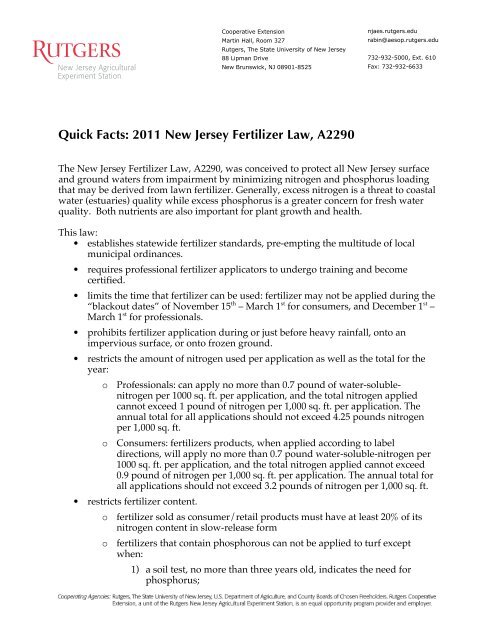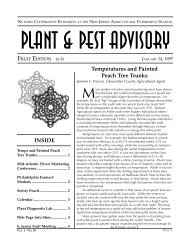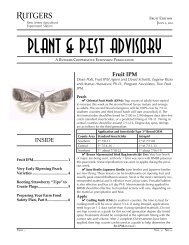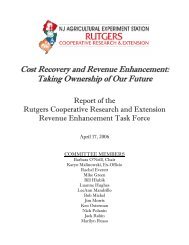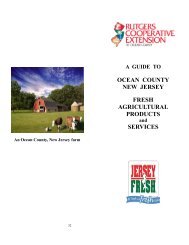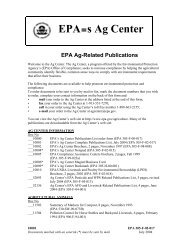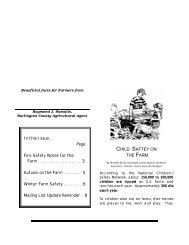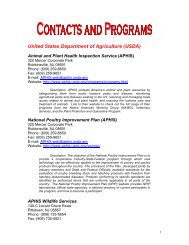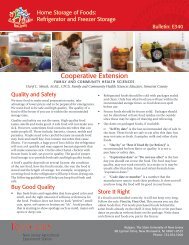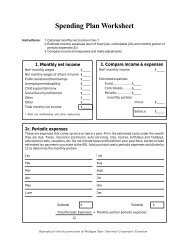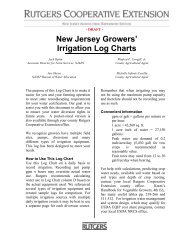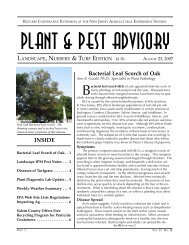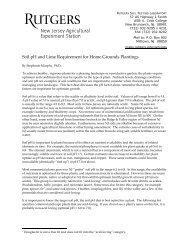Quick Facts: 2011 New Jersey Fertilizer Law, A2290 - Rutgers ...
Quick Facts: 2011 New Jersey Fertilizer Law, A2290 - Rutgers ...
Quick Facts: 2011 New Jersey Fertilizer Law, A2290 - Rutgers ...
You also want an ePaper? Increase the reach of your titles
YUMPU automatically turns print PDFs into web optimized ePapers that Google loves.
Cooperative Extension<br />
Martin Hall, Room 327<br />
<strong>Rutgers</strong>, The State University of <strong>New</strong> <strong>Jersey</strong><br />
88 Lipman Drive<br />
<strong>New</strong> Brunswick, NJ 08901-8525<br />
<strong>Quick</strong> <strong>Facts</strong>: <strong>2011</strong> <strong>New</strong> <strong>Jersey</strong> <strong>Fertilizer</strong> <strong>Law</strong>, <strong>A2290</strong><br />
njaes.rutgers.edu<br />
rabin@aesop.rutgers.edu<br />
732-932-5000, Ext. 610<br />
Fax: 732-932-6633<br />
The <strong>New</strong> <strong>Jersey</strong> <strong>Fertilizer</strong> <strong>Law</strong>, <strong>A2290</strong>, was conceived to protect all <strong>New</strong> <strong>Jersey</strong> surface<br />
and ground waters from impairment by minimizing nitrogen and phosphorus loading<br />
that may be derived from lawn fertilizer. Generally, excess nitrogen is a threat to coastal<br />
water (estuaries) quality while excess phosphorus is a greater concern for fresh water<br />
quality. Both nutrients are also important for plant growth and health.<br />
This law:<br />
• establishes statewide fertilizer standards, pre-empting the multitude of local<br />
municipal ordinances.<br />
• requires professional fertilizer applicators to undergo training and become<br />
certified.<br />
• limits the time that fertilizer can be used: fertilizer may not be applied during the<br />
“blackout dates” of November 15 th – March 1 st for consumers, and December 1 st –<br />
March 1 st for professionals.<br />
• prohibits fertilizer application during or just before heavy rainfall, onto an<br />
impervious surface, or onto frozen ground.<br />
• restricts the amount of nitrogen used per application as well as the total for the<br />
year:<br />
o Professionals: can apply no more than 0.7 pound of water-solublenitrogen<br />
per 1000 sq. ft. per application, and the total nitrogen applied<br />
cannot exceed 1 pound of nitrogen per 1,000 sq. ft. per application. The<br />
annual total for all applications should not exceed 4.25 pounds nitrogen<br />
per 1,000 sq. ft.<br />
o Consumers: fertilizers products, when applied according to label<br />
directions, will apply no more than 0.7 pound water-soluble-nitrogen per<br />
1000 sq. ft. per application, and the total nitrogen applied cannot exceed<br />
0.9 pound of nitrogen per 1,000 sq. ft. per application. The annual total for<br />
all applications should not exceed 3.2 pounds of nitrogen per 1,000 sq. ft.<br />
• restricts fertilizer content.<br />
o fertilizer sold as consumer/retail products must have at least 20% of its<br />
nitrogen content in slow-release form<br />
o fertilizers that contain phosphorous can not be applied to turf except<br />
when:<br />
1) a soil test, no more than three years old, indicates the need for<br />
phosphorus;
2) establishing turf and vegetation for the first time;<br />
3) repairing or re-establishing turf;<br />
4) applying liquid or granular fertilizer under the soil surface, directly<br />
to roots; or<br />
5) the fertilizer consists of manipulated animal or vegetable manure<br />
(organic sources). In this case, phosphorus can be included if no<br />
more than 0.25 pound of phosphorus per 1,000 sq. ft. is applied,<br />
when used according to instructions on the container.<br />
• stipulates that fertilizer bag label language follows AAPCO standard for turf<br />
fertilizer label to avoid the issue of a NJ only turf fertilizer label.<br />
• establishes buffers. <strong>Fertilizer</strong> containing nitrogen or phosphorus can not be<br />
applied to turf within 25 feet of any waterbody, except where a drop spreader,<br />
rotary spreader with a deflector, or targeted spray liquid is used, then the buffer<br />
may be reduced to 10 feet. A professional applicator may apply one “rescue<br />
treatment” annually to turf in a buffer as per rules above.<br />
• sets fines for noncompliance: $500 fine for the 1 st offense and up to $1000 for the<br />
2 nd and each subsequent offense for professional applicators. No fines for<br />
consumers.<br />
• exempts commercial farms and golf courses, except that no person, other than a<br />
certified professional fertilizer applicator or a person trained and supervised by<br />
the certified fertilizer applicator, may apply fertilizer to a golf course.<br />
When will specific parts of the law go into effect?<br />
• Effective Immediately: Sections 1: Definitions; Section 2: Prohibited fertilizer<br />
applications when: raining, on impervious surfaces, before March 1 st or after<br />
December 1 st or any time ground is frozen, and Section 9: Authorization for DEP<br />
in consultation with Department of Agriculture to adopt rules. Effective January<br />
5, 2012 -One (1) year from date of signing, the bill will go into effect requiring:<br />
All professionals to be certified; Setting limits of nitrogen content to be used by<br />
consumers and professionals and banning the use of phosphorous without soil<br />
test.<br />
• January 5, 2013 –Section 11 (label and content requirements) shall take effect two<br />
(2) years after the date of signing outlawing fertilizer products that do not meet<br />
the new content standards set by the law.<br />
02/21/<strong>2011</strong>


